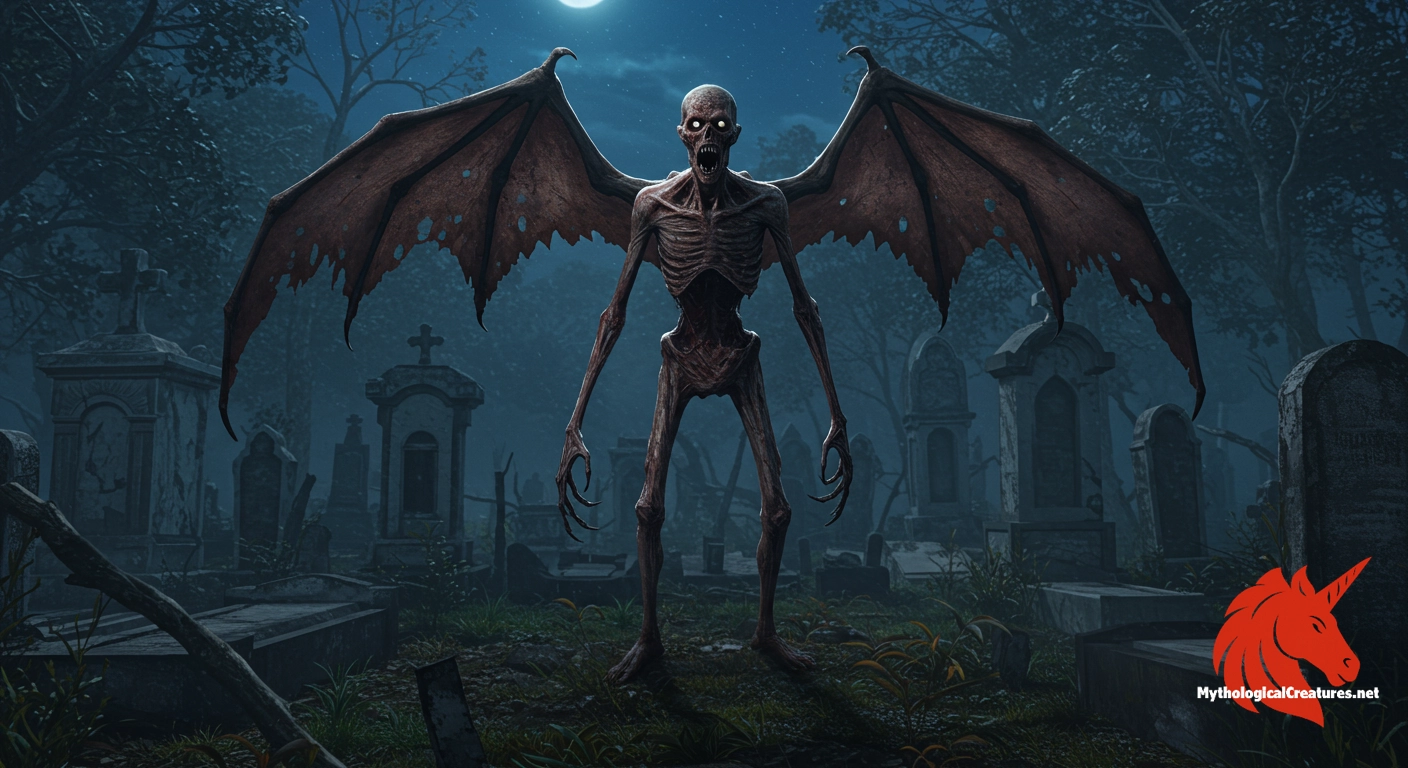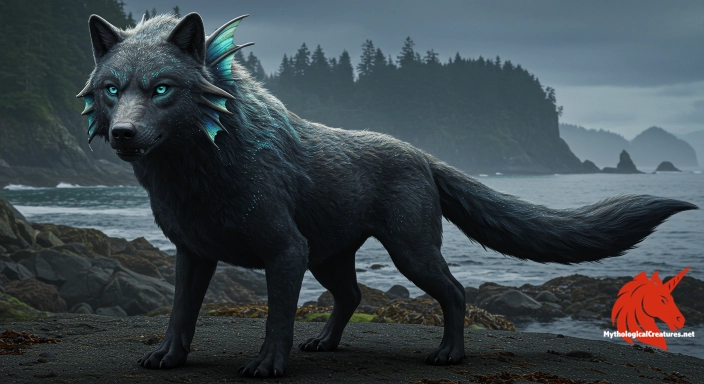Berbalang: The Berbalang is a ghoul-like creature in Filipino folklore renowned for its flesh-eating habits and supernatural flight.

Berbalang
Berbalang - Represents the macabre aspects of death and the supernatural in Filipino culture, serving as a cautionary symbol in rural communities.
Origins & First Encounters
Deeply woven into the cultural fabric of the Philippines, the Berbalangs emerge as formidable entities whose legends have been passed down through countless generations. Their myth is rooted primarily in the mystical traditions of Mindanao, where the interplay of life and death inspires both awe and trepidation. These creatures are renowned for their ghastly hunger for human flesh, a detail that underscores a broader cultural narrative about the boundaries between the living and the dead. Oral histories recount that the Berbalangs prowl under the cover of darkness, using their supernatural abilities to traverse both land and sky. Their presence in the lore not only serves as a chilling reminder of mortality but also acts as a cautionary tale to instil respect for the unknown. Over time, the narrative of the Berbalangs adapted to incorporate various local beliefs, enhancing their allure and the mystery that surrounds them. The creature’s depiction as a nocturnal predator with unearthly powers has evolved alongside regional storytelling traditions, adapting to the fears and hopes of its audience. The enduring legacy of the Berbalangs underscores their role as both a symbol of ancient superstition and a touchstone for modern myth-making.
Source Texts & Tale Variants
The primary documentation of the Berbalangs is predominantly found in the realm of oral tradition, with stories transmitted across generations in the communities of Mindanao. Early colonial records, while limited in scope, hint at the existence of similar beings through sporadic mentions in travellers’ journals and local accounts. These narratives were typically shared during communal gatherings, where the retelling of eerie encounters served both as entertainment and a societal warning. Over time, local folklore fused with anecdotal evidence, allowing the tales to adapt and flourish despite a scarcity of written sources. Variations of the story proliferated as different communities added layers of detail unique to their cultural environment. In some accounts, the Berbalangs are depicted as the cursed remnants of humankind, while in others they are seen as entirely alien entities born from the spiritual realm. The fluidity in these narratives points to a shared concern with death and the supernatural rather than a fixed mythological canon. This evolution of storytelling ensures that the Berbalangs remain a potent symbol within the cultural consciousness, even as formal documentation remains elusive.
Form & Powers
Descriptions of the Berbalangs are as varied as they are chilling, often painting a picture of a creature that defies the natural order. They are typically portrayed as having a warped and gaunt human silhouette, one that is both unsettling and transient in its form. Witness accounts frequently mention their pallid, almost translucent skin, which seems to bear the pallor of decay and the inevitability of death. Many depictions also include a pair of membranous, bat-like wings that grant them the eerie ability to glide silently through the night. Their eyes are sometimes described as glowing with an ethereal light, a feature that both mesmerises and terrifies those who cross their path. Some versions of the lore imbue these beings with additional, otherworldly features such as elongated limbs or jagged fangs, heightening their predatory essence. The combination of human and bestial traits in their appearance blurs the line between mortal form and spectral aberration. Variations in local depictions can also include unique markings, horns, or a peculiar, almost insectile quality to their movement, each detail contributing to the multifaceted image of the Berbalangs.
Regional Faces
The depiction of the Berbalangs shifts noticeably across different regions of the Philippines, mirroring the diversity of local traditions and beliefs. In the rural terrains of Mindanao, where the myth originates, these creatures are commonly associated with eerie graveyard scenes and nocturnal prowls. In neighbouring regions, however, the tales adopt subtle differences in characterisation and function. For instance, some communities stress the Berbalangs’ ability to blend into the human populace by day, only to reveal their monstrous nature under the cloak of night. Coastal and highland narratives alike have moulded the creature’s identity to reflect local spiritual rituals and taboos. These regional versions often incorporate indigenous practices, such as specific protective measures or ritualistic responses, that underscore their unique cultural context. The fluidity in detail—ranging from distinctive physical features to varied supernatural abilities—demonstrates how local environments colour the collective myth. Such variations not only enrich the legends but also offer insights into the distinct fears and values held by each community.
Cultural Parallels
Across Southeast Asia and beyond, similar spectral predators inhabit mythologies that echo the themes embodied by the Berbalangs. Their narrative finds resonance with the aswang, a well-known figure in Filipino folklore that also straddles the boundaries between human and monster. Parallels can be drawn to the Malay Penanggalan, an entity known for its detached head and visceral predation, which underscores a shared cultural motif of the dismembered spirit. The concept of a flesh-eating ghoul is also present in Arabian mythology, where stories of ghouls serve as allegories for the dangers lurking in the shadowy fringes of society. Despite these similarities, the Berbalangs retain distinctive characteristics that root them firmly in Filipino cultural and spiritual contexts. The local embellishments—whether in their method of flight or the subtle human traits they preserve—highlight the interplay between shared human fears and the unique influences of regional belief systems. Comparative explorations of these figures reveal a broader, cross-cultural narrative about the fragility of the human condition and the omnipresent threat of the otherworldly. This intertextuality among global myths provides a rich backdrop for understanding how different societies encapsulate their collective anxieties in the form of malevolent spirits.
Legacy & Modern Evolution
Over centuries, the narrative of the Berbalangs has undergone a remarkable transformation, evolving from cautionary tales of spectral terrors into layered symbols within modern cultural discourse. Once confined to the whispered legends of rural communities, these beings have now found a vibrant new life in literature, cinema, and digital media. Contemporary portrayals often amplify their supernatural abilities while integrating modern elements that resonate with today’s audiences. As filmmakers and writers reinterpret the old legends, the Berbalangs have become emblems of the eerie convergence between tradition and modernity. Modern horror genres embrace the timeless terrour evoked by these creatures, while artists experiment with visual depictions that marry traditional aesthetics with current stylistic innovations. Such reimaginings have transformed the Berbalangs into icons emblematic of existential fears, societal taboos, and the enduring allure of myth. This ongoing evolution highlights the adaptability of folklore, demonstrating how legends can survive and thrive by reflecting contemporary cultural landscapes. As newer generations add their own interpretations, the legacy of the Berbalangs remains a potent reminder of the power of myth to transcend time and continually capture the collective imagination.
Interesting Fact
An intriguing facet of the Berbalang is its thematic overlap with other Filipino mythological creatures like the Aswang, highlighting a rich cultural narrative that intertwines supernatural predation with local beliefs about death and the afterlife.
Quick Creature Info
Origin:
Features:
Associations:
Our Mythic Legendary Rating:

Habitat:
Supernatural Powers:
Physical Attributes:
Abilities:
Behavior:
Lore:
Related Creatures, Tales or Lore
References
Discover Another Mythical Legend You May Not Have Heard Of?
Uncover the mysteries of ancient folklore and expand your knowledge of legendary beings from cultures around the world.
Dare to Meet the Gonakadet....
Mythical Disclaimer: The images and data on this site are derived from various historical and literary sources, but we have found that many myths often have multiple versions and interpretations across references, sometimes contradictory. As a result, these creature depictions are artistic interpretations—imaginative blends of folklore, legend, and a dash of AI guesswork. Because creature descriptions vary widely, our illustrations and accompanying information represent our best effort to honor mythology while bridging creative gaps. Enjoy these interpretations—just remember, we've done our best to respect the stories and validate available data, but in the realm of mythology, details often shift, imagination leads the way, and nothing is ever set in stone!
Curated by the Mythological Creatures Team (rev. May 2025)
